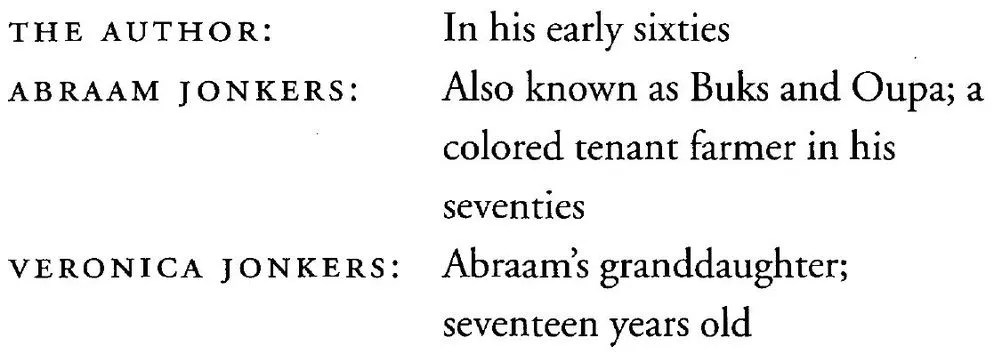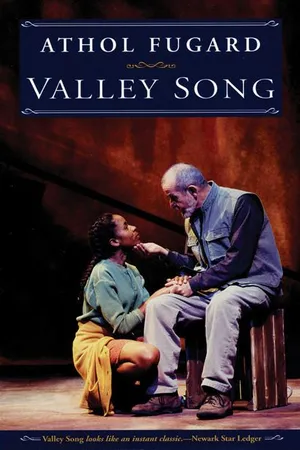eBook - ePub
Valley Song
About this book
Valley Song is a tender poem of deep, deep love between two human beings, a story of rebirth, and of miracles at hand.
—John Heilpern, New York Observer
Rarely has a playwright been so closely identified with his country and his people as Athol Fugard. Fugard's extensive body of work has served as one of the moral beacons during and after apartheid in South Africa, and in Valley Song—a coming-of-age story about a young girl seeking the courage to embrace the future while her grandfather searches for the wisdom to let go of the past—he applied his great gift to the work of healing and of envisioning the future.
Frequently asked questions
Yes, you can cancel anytime from the Subscription tab in your account settings on the Perlego website. Your subscription will stay active until the end of your current billing period. Learn how to cancel your subscription.
No, books cannot be downloaded as external files, such as PDFs, for use outside of Perlego. However, you can download books within the Perlego app for offline reading on mobile or tablet. Learn more here.
Perlego offers two plans: Essential and Complete
- Essential is ideal for learners and professionals who enjoy exploring a wide range of subjects. Access the Essential Library with 800,000+ trusted titles and best-sellers across business, personal growth, and the humanities. Includes unlimited reading time and Standard Read Aloud voice.
- Complete: Perfect for advanced learners and researchers needing full, unrestricted access. Unlock 1.4M+ books across hundreds of subjects, including academic and specialized titles. The Complete Plan also includes advanced features like Premium Read Aloud and Research Assistant.
We are an online textbook subscription service, where you can get access to an entire online library for less than the price of a single book per month. With over 1 million books across 1000+ topics, we’ve got you covered! Learn more here.
Look out for the read-aloud symbol on your next book to see if you can listen to it. The read-aloud tool reads text aloud for you, highlighting the text as it is being read. You can pause it, speed it up and slow it down. Learn more here.
Yes! You can use the Perlego app on both iOS or Android devices to read anytime, anywhere — even offline. Perfect for commutes or when you’re on the go.
Please note we cannot support devices running on iOS 13 and Android 7 or earlier. Learn more about using the app.
Please note we cannot support devices running on iOS 13 and Android 7 or earlier. Learn more about using the app.
Yes, you can access Valley Song by Athol Fugard in PDF and/or ePUB format, as well as other popular books in Literature & African Drama. We have over one million books available in our catalogue for you to explore.
Information
NOTES
Karoo: A vast semi-desert region in the heart of South Africa. “Karoo” is a Khoi word meaning “place of little water.” Several mountain ranges dot the Karoo, among them the Sneeuberg (Snow Mountains) in the southeast, whose highest peak (6300 feet) is the Kompassberg. Few plants grow on the dry mountains, but farms thrive in the valleys and lowlands. Most of the inhabitants of the Karoo are either white Afrikaners or coloreds.
The Valley: A fertile valley deep in the Sneeuberg; fruits, vegetables and alfalfa are produced there. At this time, all of the farmland is still owned by whites.
The Village: The small town of Nieu-Bethesda. Resident white population: 65; colored population: 950. Like most rural South African villages, Nieu-Bethesda is still essentially divided into two areas: the white town and the outlying “location” populated by coloreds and blacks.
Coloreds: One of four official racial categories (along with whites, blacks and Asians) of the “old” South Africa. Colored is defined as anyone of mixed racial descent. The Colored population of South Africa is approximately 4.5 million; their language is Afrikaans.
In the Karoo the earth is red and covered with small sage and milk bushes; the air is so still and clear that objects miles away seem close to you and sound travels as far as the eye can see. Day after cloudless day the sunburnt plains shimmer beneath the blue African sky; a little hillock stands out in sharp relief and, in the distance—which gives the impression of being infinite—you may see a white-painted farmhouse surrounded by orange trees. There is nothing else. This is the Karoo. And for those who have lost their hearts to it, no other place on earth can compare.
—Carolyn Slaughter

The Karoo, once you have been given the hint, is the eroded ruins of a world, the great lake and its giant reptiles gone but for a few bones and ripple marks, gone like the Sodom and Gomorrah in the earthquake and fire, epochs of reptilian life abolished, stone scorched and purged, and then sculpted clean and bare into noble shapes, the tactics of the elemental artist spelt out in the fine sand of the watercourses, his signature clear in the cirrus clouds...In that vast semi-desert it is difficult to forget your smallness.
—Guy Butler
I cannot describe my early response to the beauty of hill and stream and tree as anything less than an ecstasy...I was much older before I responded, no less intensely, to the beauty of plain and sky and distant lines of mountains. When I first saw the expanse of the...desolate stretches of the Karoo I did not at once acknowledge that they were beautiful. The qualities of harshness, starkness and seeming endlessness did not seem to me to be compatible with beauty.
—Alan Paton

The Man Born to Farming
The grower of trees, the gardener, the man born to farming, whose hands reach into the ground and sprout, to him the soil is a divine drug. He enters into death yearly, and comes back rejoicing. He has seen the light lie down in the dung heap, and rise again in the corn. His thought passes along the row ends like a mole. What a miraculous seed has he swallowed that the unending sentence of his love flows out of his mouth like a vine clinging in the sunlight, and like water descending in the dark?
—Wendell Berry
Seeds are many things, but everything about seeds—their numbers and forms and structures—has a bearing on their main purpose, to insure continuing life. Seeds are containers of embryonic plants, the embryos of a new generation. Most seeds are objects of beauty of form, proportion, surface and color. Many seeds are so small that their beautiful features escape us. Many others, although large enough to see easily, are such common, everyday objects that we do not really see them. They are, however, worth our careful observation.
—U.S. Department of Agriculture Yearbook, 1961
CHARACTERS

TIME
The present
AUTHOR’S NOTE
The role of the Author and Abraam Jonkers must be played by the same actor.
A bare stage. Enter the Author. He comes down and speaks directly to the audience.
AUTHOR (A handful of pumpkin seeds): Pumpkin seeds, ladies and gentlemen...genuine Karoo pumpkin seeds. I can vouch for that. I grew the pumpkin myself last summer, cut it open, scooped out the seeds and dried them under a hot Karoo sun. This is the so-called “Flat White Boer” variety. That’s the actual name. Flat White Boer pumpkin. I don’t think I’ve ever seen that sort here in America. As the name tells you, its flat, about five or six inches deep, round, on an average about twelve to eighteen inches across, white...and delicious eating! But only as a vegetable. We unfortunately don’t have a pumpkin pie tradition in South Africa. Anyway, this is how they start out...one of these together with a little prayer for rain in a hole in the ground, and in a good year, when you get that rain, this little handful could easily give you up to a hundred of those beauties.
In my little Village in the Sneeuberg Mountains spring is now well underway and everyone has already planted their pumpkin seeds. The seasons are of course reversed down there and by the time you reach November the danger of a late frost is past. With any luck the Valley has had its first rain and that wonderful smell of damp Karoo earth is mingled with the fragrance of roses and pine trees. After its long winter sleep that little world is wide awake once again and rowdy with birdsong and bleating lambs and noisy children.
Imagine a day like that, a glorious Karoo spring day! and these seeds in the hands of old Abraam Jonkers—in the Village we all just call him “ou Buks.” He’s out there in his akkers behind the derelict old Landman house with his spade, planting—a little stab at the ground and then a seed, stab at the ground and a seed—it’s a well-rehearsed action. He’s planted a lot of pumpkin seeds in the course of his seventy-six years. And there’s nothing haphazard about what he’s doing either. When the young plants come up he wants to see them standing shoulder to shoulder in lines as straight as those the Sergeant Major drilled them into on the Sonderwater Parade Ground during the Second World War. Buks was a corporal in that famous old colored regiment, the Cape Corps, and was stationed up in the Transvaal guarding Italian prisoners of war. He’s in fact thinking about those days as he drops the seeds into the ground. One of the prisoners became a good friend of his and taught him a couple of Italian songs. He’s trying very hard to remember one of them—they are now the only souvenirs he’s got left of that time. Everything else—badges and brass buttons, discharge papers and scraps of his old uniform, even his old army kitbag—are either lost or disintegrated with time. Only the song is left and even that has moldered away to only half the memory it used to be. It went something like this:
In the course of the song he moves into the character of Buks.
BUKS:
Lae donder mobili
En soo moretsa
da da de da da da...
En soo moretsa
da da de da da da...
Veronica enters. She carries Buks’s lunch: bottle of tea, sandwic...
Table of contents
- BOOKS BY ATHOL FUGARD - AVAILABLE FROM TCG
- Title Page
- Copyright Page
- Dedication
- PRODUCTION HISTORY
- NOTES
